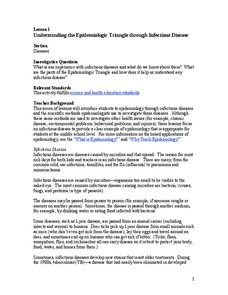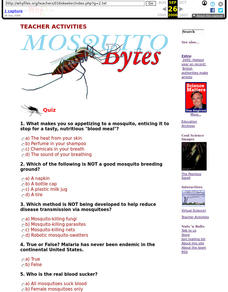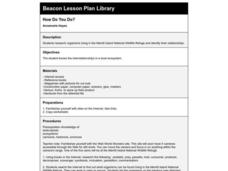Parasites Teacher Resources
Find Parasites lesson plans and worksheets
Showing 482 resources
Curated OER
Chewin' in the Chesapeake
Students examine a web page on food webs and select a habitat to research. In this research lesson students identify the organisms found in the food web and present their findings to the class.
Curated OER
Design That Makes a Difference: Focus on Shelters and Water
Students analyze three different types of temporary shelters and their designs for environmental factors. In this shelter design lesson, students analyze how designers address environmental problems for homeless or refugees. Students...
Curated OER
Supermarkets, Sustenance and Sustainability
Students investigate jungles and the people who depend upon them. In this sustainability lesson, students research wild life conservation and discover the importance of a jungle to Amazonian people. Students create a group...
Curated OER
Understanding the Epidemiologic Triangle through Infectious Disease
Students examine the epidemiologic triangle. In this disease lesson, students discuss infectious disease as they study how they spread and discover their families' experiences with them. Students research Internet sites to complete...
Curated OER
Mosquitos
In this mosquitos worksheet, learners answer multiple choice questions about mosquitos. Students answer 5 questions about mosquitos.
Curated OER
Wetlands - Food Web Relationships
In this food web relationships activity, students click on the links to learn about the food web relationships in the wetlands and answer short answer questions about it. Students complete 8 questions total.
Curated OER
Arthropods Crossword
In this arthropods worksheet, students complete a crossword puzzle with 41 questions about the different types and behaviors of arthropods.
Curated OER
Meerkat Quiz
In this habitats worksheet, 4th graders answer 11 multiple choice questions about the lives, the habitat and the social skills of the meerkats, with answers included.
Curated OER
Plant Galls
Students study what a plant gall is and the different types that there are. In this plant lesson students examine what causes galls and how to prevent them.
Curated OER
Earth's Recyclers
Middle schoolers work together in groups to report on different topics related to decomposition. They answer questions and share their answers with the class. They discuss any topic that is unclear.
Curated OER
How Do You Do?
Seventh graders research organisms in the Merritt Island National Wildlife Refuge. They create a picture book demonstrating their understanding of relationships.
Curated OER
Word Scramble – Lesson 3
In this health worksheet, students identify and define vocabulary terms related to foodborne illness. They unscramble the words listed at the bottom of the sheet and use them to complete each of 8 blanks.
Curated OER
Saving Habitat
Students pick an animal native to Maryland and research how populations of that animal might be affected by land use changes over the past thirty years. They predict population trends for the next thirty years.
Curated OER
Habitats and Functions
Learners analyze and discuss insect diversity and all of the functions that insects perform in nature. They examine habitat and function cards, and distribute themselves by function and habitat.
Curated OER
Black Pearls
Students examine where pearls come from and where mollusks are found. They discover how pearls are formed in nature and how they are they made by humans. They use ordinary oyster shells to examine mother of pearl.
Curated OER
Household Pests
Sixth graders discover the various habitat requirements for assorted household pests from ants to wasps. They conduct various activities including researching the life cycles moths, cockroaches, and mosquitoes
Curated OER
Immune System Function
Students study the different facets of the Human immune system, including the functions of all the different organs in the immune system.
Curated OER
Fish Diseases
Young scholars discuss sicknesses they have had or come in contact with. They discuss treatments for the diseases on the list. Students discuss illnesses that fish might get along with the symptoms, behavior and treatment.
Curated OER
A Day in the Life
Students use their research skills to investigate the behavior and characteristics of a rainforest animal. After creating a diary entry, they illustrate the habits and life cycle of the animal. They write the diary entry from the point...
Curated OER
Plant Dye Paints
Learners create original paintings using natural dye techniques used in the past in this Art lesson plan about paint colors. The lesson plan may be supplemented with information about pioneers, or ancient civilizations, and how paints...
Curated OER
Integrated Pest Management
Students compare and contrast the role of the honeybee in nature. They find information by using a variety of resources that could include the internet. Students take part in a paper and pencil formal evaluation with questions that...
Curated OER
Viruses and Host Evolution
Students research viruses and their effects on the evolution of a rabbit population. They complete a teacher created worksheet of questions on their research. They present their research to classmates.
Curated OER
Spring Collecting and Identifying Bumble Bees
Students collect bumble bees in the field, record data, pin and label specimens, answer conclusion questions, and send specimens to research leaders for verification. They improve their ability to work in research teams. Students...
Curated OER
Spring Collecting and Identifying Bumble Bees
Students collect bumble bees in the field, record data, identify and release specimens, answer conclusion questions, and send data in to researcher leaders. They make research based conclusions based upon the evidence.
Other popular searches
- Parasites in Taiga
- Taiga Parasites
- Animal Parasites
- Types of Parasites
- Human Parasites
- Parasites Science
- Veterinary Parasites
- Parasites Bacteria
- Life Cycle of Parasites
- Bacteria Viruses Parasites
- Hosts and Parasites
- Parasites and Agriculture

























